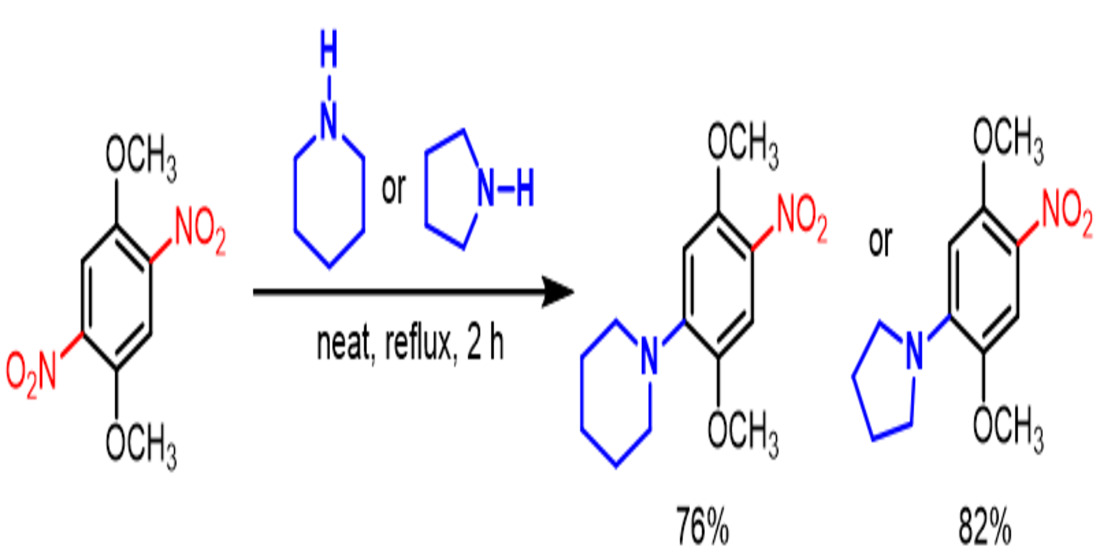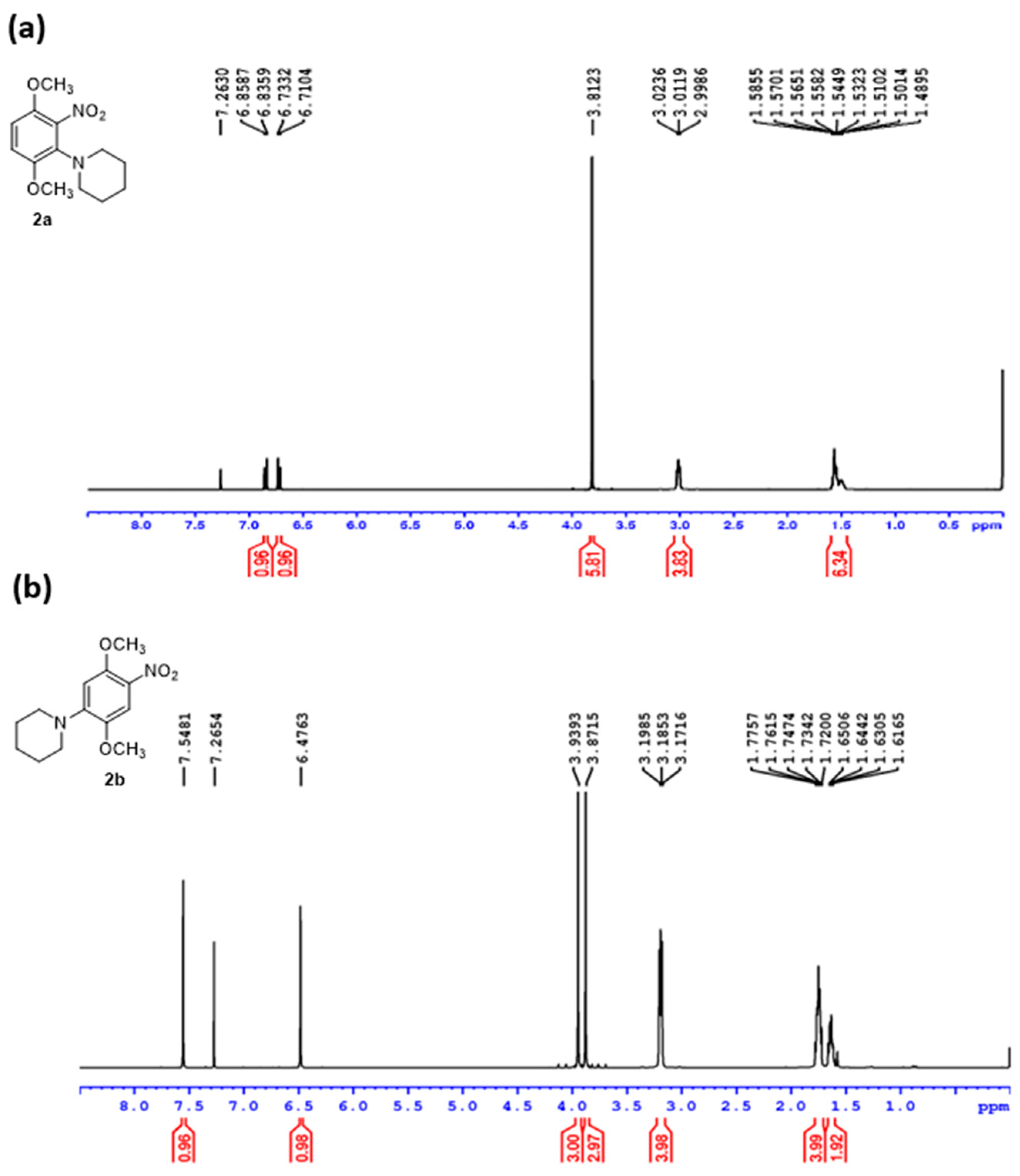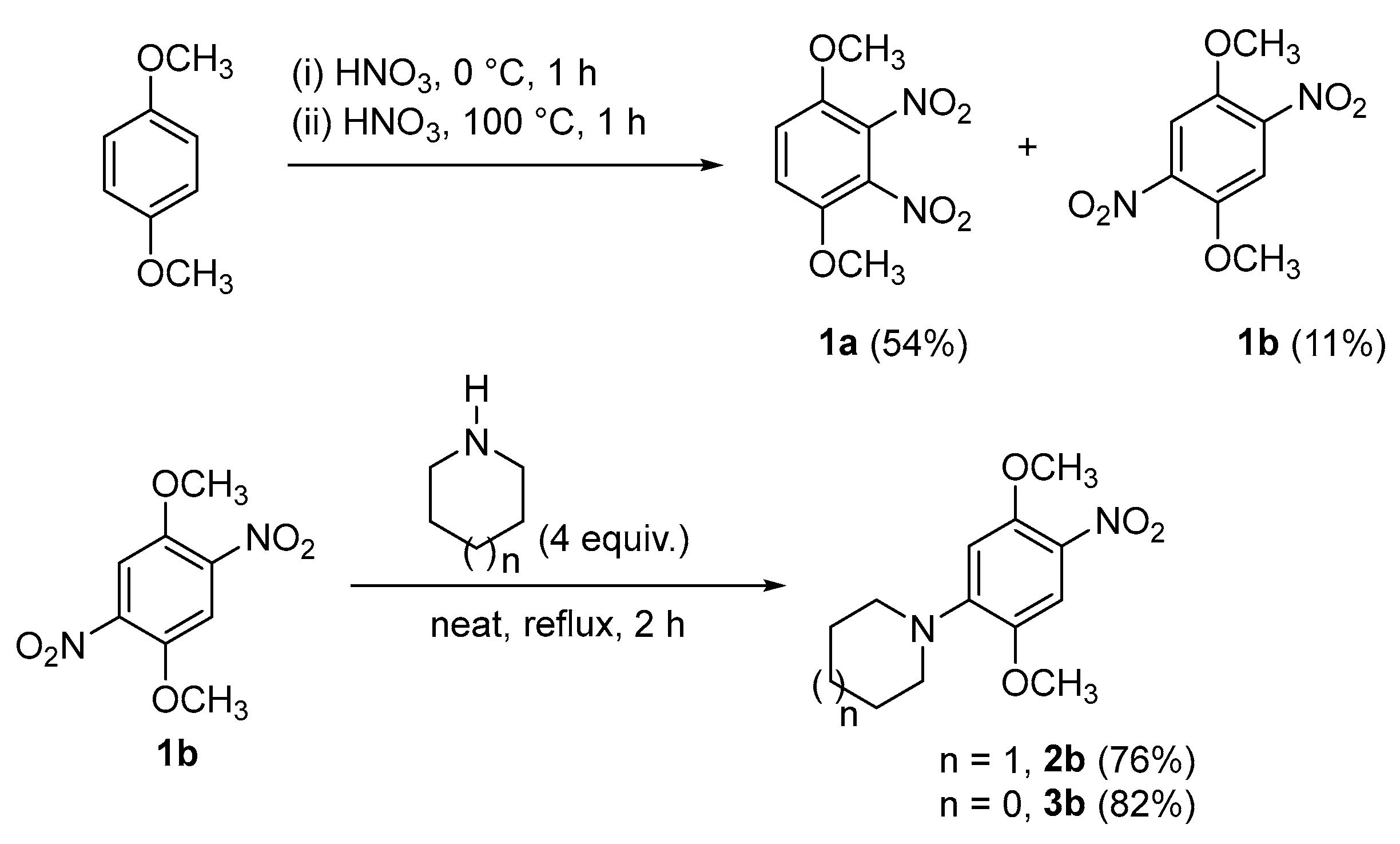Preprint
Short Note
1-(2,5-Dimethoxy-4-nitrophenyl)piperidine and 1-(2,5-dimethoxy-4-nitrophenyl)pyrroridine
This version is not peer-reviewed.
Submitted:
14 November 2023
Posted:
15 November 2023
You are already at the latest version
A peer-reviewed article of this preprint also exists.
Abstract
Treatment of the non-purified mixture of dinitro isomers obtained from the nitration of 1,4-dimethoxybenzene with piperidine, led to the isolation of novel but minor adduct, 1-(2,5-dimethoxy-4-nitrophenyl)piperidine (2b) in 15% yield. Yields of nucleophilic aromatic substitution adducts are high when using purified 1,4-dimethoxy-2,5-dinitrobenzene (1b) with piperidine and pyrrolidine to give 2b and 1-(2,5-dimethoxy-4-nitrophenyl)pyrrolidine (3b) in 76% and 82%, respectively.

Keywords:
Subject:
Chemistry and Materials Science - Organic Chemistrysupplementary.zip (682.10KB )
1. Introduction
1,4-Dimethoxy-2,3-dintrobenzene (1a) is the precursor for the synthesis of potent bioreductive anti-cancer agents [1,2], the benzimidazole-4,7-diones [3,4] and ring-fused benzimidazolequinones [5,6]. For example, pyrido[1,2-a]benzimidazolequinone (Figure 1), which is 300 times more cytotoxic than the clinical anti-tumor drug, mitomycin C under hypoxic conditions, associated with solid tumors [5,7].
2. Results and Discussion
To expediate the synthesis of pyrido[1,2-a]benzimidazolequinone (Figure 1) [7], the non-purified mixture of dinitro isomers 1a and 1b from the nitration of 1,4-dimethoxybenzene was subjected to heating in piperidine under reflux giving 1-(3,6-dimethoxy-2-nitrophenyl)piperidine (2a) and 1-(2,5-dimethoxy-4-nitrophenyl)piperidine (2b) in 43% and 15% yield respectively (Scheme 1).
The NMR spectra show distinct differences in the aromatic region for isomers 2a and 2b. The para-arrangement of the piperidinyl- and nitro-substituents of 2b gives well-separated singlets (at 6.48 and 7.55 ppm for H-6 and H-3, respectively, Figure 2b), in comparison to the two aromatic doublets (at 6.72 and 6.84 ppm, J = 9.1 Hz, of 4,5-H) in the 1H NMR spectrum of 2a (Figure 2a [7]).
Given that nucleophilic aromatic substitution adducts of 2,5-dintrobenzene 1b are novel (see below), column chromatography was used to separate 1b (11%) on gram scale from major isomer 1a (54%) after nitration of 1,4-dimethoxybenzene (Scheme 2). Heating purified 1b in piperidine at reflux gave 1-(2,5-dimethoxy-4-nitrophenyl)piperidine (2b) in 76% yield with the analogous reaction with pyrrolidine giving 1-(2,5-dimethoxy-4-nitrophenyl)pyrrolidine (3b) in 82% yield. The pyrrolidine adduct 3b was isolated without the requirement for purification (chromatography or recrystallization), with only evaporation of the reaction mixture carried out after EtOAc-brine extraction. There is no literature data available for adducts 2b and 3b, and thus the compounds are assumed to be new, although 3b is listed in the catalogues of two Chinese suppliers [10,11].
3. Materials and Methods
3.1. Materials and Measurements
All chemicals were sourced from commercial suppliers and used without purification, including piperidine (99%, Thermo scientific), and pyrrolidine (98%, TCI). Nitric acid (69%, EMSURE®, Merck) and 1,4-dimethoxybenzene (9.95 g, 72.0 mmol, ReagentPlus® 99%, Sigma-Aldrich) gave the mixture of dinitro-isomers (11.67 g, 71%, ratio in Scheme 1), according to this literature procedure [9]. Thin layer chromatography (TLC) was performed on Merck TLC silica gel 60 F254 plates using a UV lamp (254 nm) for visualization. Flash chromatography and dry column vacuum chromatography (DCVC) were performed using Fluka silica gel 60 (particle size 35–70 µm) and Milipore silica gel 60 (particle size 15–40 µm), respectively, using gradient elution of EtOAc (Fischer Scientific, ≥ 99%) and hexanes (Fischer Scientific, bp 40–60 °C), as eluent. The organic extract was dried using MgSO4 (anhydrous, Fisher Scientific, Extra Pure). Melting point was measured on a Stuart Scientific melting point apparatus, SMP3. Infrared spectrum (IR) was recorded on the solid samples using a Perkin-Elmer Spec 1 with ATR attached, where s, m, and w are strong, medium, and weak signals, respectively. All NMR spectra were recorded in CDCl3 (Eurisotop®, 99.8% atom D) using a Bruker Avance III 400 MHz spectrometer equipped with a 5 mm BBFO+, broadband autotune probe and controlled with TopSpin 3.5.7 acquisition software and IconNMR 5.0.7 automation software Copyright © 2017 Bruker BioSpin GmbH. Chemical shifts are in ppm relative to tetramethylsilane (TMS). 13C NMR spectra were acquired at 100 MHz with complete proton decoupling. NMR assignments are supported by DEPT-135, 1H−1H COSY and 1H−13C edited HSCQ correlation. HRMS spectra of compounds 2b and 3b were obtained at the National Mass Spectrometry Facility at Swansea University using a Waters Xevo G2-S mass spectrometer with an Atmospheric Solids Analysis Probe (ASAP). The precision of all accurate mass measurements was better than 5 ppm.
3.2. Synthesis of 1-(2,5-dimethoxy-4-nitrophenyl)piperidine (2b)
The mixture of 2,3-dintrobenzene 1a and 2,5-dintrobenzene 1b (82:18% ratio by 1H NMR, 0.800 g, 3.5 mmol) and piperidine (1.38 ml, 14.0 mmol) was stirred at reflux for 2 h. EtOAc (20 ml) was added to the cool red residue, which was washed with brine (3 x 30 ml). The organic layer was dried (MgSO4) and evaporated to dryness. The residue was purified by DCVC using gradient elution of EtOAc/hexane to give 1-(3,6-dimethoxy-2-nitrophenyl)piperidine (2a [7]) (0.400 g, 43%), as a yellow solid, Rf 0.51 (3 : 7 EtOAc : hexane); and the title compound 2b (0.140 g, 15%) as an yellow solid; mp 126–127 °C; Rf 0.30 (3 : 7 EtOAc : hexane); νmax (neat, cm-1) 2929 (m), 2853 (w), 1610 (m), 1571 (m), 1509 (s), 1444 (m), 1312 (s), 1266 (s), 1243 (s), 1210 (s); δH (400 MHz, CDCl3) 1.62-1.65 (m, 2H, 3’-CH2), 1.72-1.78 (m, 4H, 2’-CH2), 3.19 (t, 4H, J = 5.4 Hz, 1’-CH2), 3.87 (s, 3H, 2-CH3), 3.94 (s, 3H, 5-CH3), 6.48 (s, 1H, 6-H), 7.55 (s, 1H, 3-H); δC (100 MHz, CDCl3) 24.2 (3’-CH2), 25.9 (2’-CH2), 51.4 (1’-CH2), 56.2 (CH3), 56.9 (CH3), 103.0 (6-CH), 109.3 (3-CH), 130.7, 144.8, 149.3, 150.5 (all C); HRMS (API+) m/z [M + H]+, C13H19N2O4 calcd. 267.1345, observed 267.1345.
Alternatively, 2,5-Dinitrobenzene 1b (0.200 g, 0.9 mmol) and piperidine (0.35 ml, 3.6 mmol) were stirred at reflux for 2 h. EtOAc (20 ml) was added to the cool red residue, which was washed with brine (3 x 30 ml). The organic layer was dried (MgSO4) and evaporated to dryness. The residue was purified by DCVC using gradient elution of EtOAc/hexane to give the title compound 2b (0.182 g, 76%) as a yellow solid (spectroscopic data identical to above).
3.3. Synthesis of 1-(2,5-dimethoxy-4-nitrophenyl)pyrrolidine (3b)
2,5-Dinitrobenzene 1b (0.286 g, 1.3 mmol) and pyrrolidine (0.42 ml, 5.0 mmol) were stirred at reflux for 2 h. EtOAc (20 ml) was added to the cool brown residue, which was washed with brine (3 x 30 ml). The organic layer was dried (MgSO4) and evaporated to dryness to give the title compound 3b (0.268 g, 82%), as an orange solid; mp 104–106 °C; Rf 0.45 (2 : 3 EtOAc : hexane); νmax (neat, cm-1) 2966 (w), 1608 (m), 1565 (m), 1526 (s), 1482 (m), 1450 (m), 1367 (w), 1287 (s), 1268 (s), 1218 (s); δH (400 MHz, CDCl3) 1.91-1.95 (m, 4H, 2’-CH2), 3.54-3.57 (m, 4H, 1’-CH2), 3.74 (s, 3H, CH3), 3.89 (s, 3H, CH3), 5.96 (s, 1H, 6-H), 7.53 (s, 1H, 3-H); δC (100 MHz, CDCl3) 25.5 (2’-CH2), 50.8 (1’-CH2), 56.6 (2 x CH3), 97.1 (6-CH), 110.2 (3-CH), 126.1, 141.3, 146.1, 152.4 (all C); HRMS (API+) m/z [M + H]+, C12H17N2O4 calcd. 253.1188, observed 253.1187.
Supplementary Materials
The following are available online at www.mdpi.com/xxx/s1: IR, 1H, 13C NMR spectra and HRMS for compounds 2b and 3b, and 2D NMR correlation spectra for 2b.
Author Contributions
Methodology: T.M.S., M.R.A., I.B., and M.M. Conceptualization, Supervision, Writing – review & editing: F.A. All authors have read and approved the manuscript.
Acknowledgements
This manuscript was completed as part of the MPharm dissertation of T.M.S. and MSc dissertations of M.R.A., and I.B. We thank Kingston University for analytical facilities and Swansea University for mass spectra.
Conflicts of Interest
The authors declare no conflict of interest.
References
- Haji, N.; Faizi, M.; Koutentis, P. A.; Carty, M. P.; Aldabbagh, F. Heterocyclic iminoquinones and quinones from the National Cancer Institute (NCI, USA) COMPARE Analysis. Molecules 2023, 28, 5202. [Google Scholar] [CrossRef] [PubMed]
- Sweeney, M.; Conboy, D.; Mirallai, S. I.; Aldabbagh, F. Advances in the synthesis of ring-fused benzimidazoles and imidazobenzimidazoles. Molecules 2021, 26, 2684. [Google Scholar] [CrossRef] [PubMed]
- Gellis, A.; Kovacic, H.; Boufatah, N.; Vanelle, P. Synthesis and cytotoxicity evaluation of some benzimidazole-4,7-diones as bioreductive anticancer agents. Eur. J. Med. Chem. 2008, 43, 1858–1864. [Google Scholar] [CrossRef] [PubMed]
- O’Donovan, L.; Carty, M. P.; Aldabbagh, F. First synthesis of N-[(aziridin-2-yl)methyl]benzimidazolequinone and analysis of toxicity towards normal and Fanconi anemia cells. Chem. Commun. 2008, 5592–5594. [Google Scholar] [CrossRef] [PubMed]
- Lynch, M.; Hehir, S.; Kavanagh, P.; Leech, D.; O'Shaughnessy, J.; Carty, M. P.; Aldabbagh, F. Synthesis by radical cyclization and cytotoxicity of highly potent bioreductive alicyclic ring fused [1,2-a]benzimidazolequinones. Chem. Eur.J. 2007, 13, 3218–3226. [Google Scholar] [CrossRef] [PubMed]
- Moriarty, E.; Carr, M.; Bonham, S.; Carty, M. P.; Aldabbagh, F. Synthesis and toxicity towards normal and cancer cell lines of benzimidazolequinones containing fused aromatic rings and 2-aromatic ring substituents. Eur. J. Med. Chem. 2010, 45, 3762–3769. [Google Scholar] [CrossRef] [PubMed]
- Sweeney, M.; Gurry, M.; Keane, L. -A. J.; Aldabbagh, F. Greener synthesis using hydrogen peroxide in ethyl acetate of alicyclic ring-fused benzimidazoles and anti-tumour benzimidazolequinones. Tetrahedron Lett. 2017, 58, 3565–3567. [Google Scholar] [CrossRef]
- Shopsowitz, K.; Lelj, J.; MacLachlan, M. J. Regioselectivity in the nitration of dialkoxybenzenes. J. Org. Chem. 2011, 76, 1285–1294. [Google Scholar] [CrossRef] [PubMed]
- Hammershøj, P.; Reenberg, T. K.; Pittelkow, M.; Nielsen, C. B.; Hammerich, O.; Christensen, J. B. Synthesis and properties of 2,3-dialkynyl-1,4-benzoquinones. Eur. J. Org. Chem. 2006, 2786–2794. [Google Scholar] [CrossRef]
- CAS Registry Number: 71230-77-8, Catalogue Number: CA0784117. Chemieliva Pharmaceutical, Product List, Jiang Bei Chongqing, China. https://www.chemieliva.com/new_content.html?casno=71230-77-8 (accessed 16/10/2023).
- CAS Registry Number: 71230-77-8, Catalogue Number: PR-518937. Atomax Chemicals, Product List, Shenzhen, Guangdong, China. http://en.atomaxchem.com/71230-77-8.html (accessed 16/10/2023).
Scheme 1.
Yields of adducts 2a and 2b after dry column vacuum chromatography (DCVC).

Figure 2.
1H NMR spectra of (a) 2a [7], and (b) novel isomer 2b.
Figure 2.
1H NMR spectra of (a) 2a [7], and (b) novel isomer 2b.

Scheme 2.
Synthesis 1,4-dimethoxy-2,5-dintrobenzene (1b) and derived novel adducts 2b and 3b.

Disclaimer/Publisher’s Note: The statements, opinions and data contained in all publications are solely those of the individual author(s) and contributor(s) and not of MDPI and/or the editor(s). MDPI and/or the editor(s) disclaim responsibility for any injury to people or property resulting from any ideas, methods, instructions or products referred to in the content. |
© 2023 by the authors. Licensee MDPI, Basel, Switzerland. This article is an open access article distributed under the terms and conditions of the Creative Commons Attribution (CC BY) license (http://creativecommons.org/licenses/by/4.0/).
Copyright: This open access article is published under a Creative Commons CC BY 4.0 license, which permit the free download, distribution, and reuse, provided that the author and preprint are cited in any reuse.
Alerts
MDPI Initiatives
Important Links
© 2025 MDPI (Basel, Switzerland) unless otherwise stated







